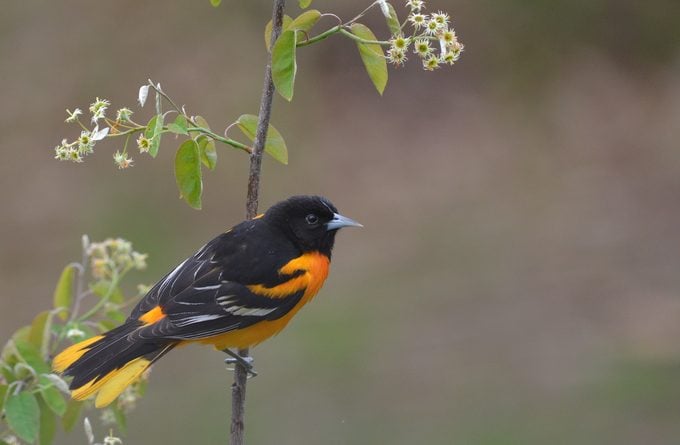With spring flowers, summer berries and fall colors, native serviceberry trees and shrubs are a delight in all seasons and good for wildlife.

Serviceberry Tree Care and Growing Tips

On This Page
Why You Should Grow Serviceberry

- Botanical name: Amelanchier spp.
- Common names: serviceberry, juneberry, shadblow, shadbush, Saskatoon, sugarplum
- Hardiness zones: 3 to 9, depending on species
- Light needs: full sun to partial shade
- Water needs: average, consistent moisture, drought tolerant once established
- Soil needs: well-drained, acidic to neutral, sandy to loamy, varies by species
- Size: 8-foot bush to 30-foot tree, 4- to 15-feet wide, depending on species
- Attracts: Birds, bees, butterflies and other pollinators
Whether they’re in the shape of a tree or bush, serviceberries bring a spectacle for every season. Showy white spring flowers give way to lush green summer foliage and rosy berries. Fall leaves turn stunning shades, before winter makes it easy to appreciate their ornamental bark and attractive structure.
“Serviceberries offer aesthetic appeal and versatility,” says Laura Root, a horticulturist at Park Seed. “They can be used as a specimen tree, hedge or in naturalized plantings.”
But their looks aren’t even the main attraction. That distinction goes to the wildlife they attract. Birds and mammals depend on their berries, while bees and other pollinators thrive off of their nectar and pollen.
“Overall, serviceberries are adaptable, promote a healthy ecosystem, support biodiversity, require minimal care and bring year-round interest,” says Mary Phillips of the National Wildlife Federation.
When and Where to Plant a Serviceberry Tree

Serviceberries thrive in full sun to part shade. They prefer well-drained soil and consistent moisture, but depending on the species can also be drought-tolerant. What type of soil composition they excel in also depends on the species.
“They can serve as a great accent tree, so they should be placed where they can be viewed easily,” says Sharon Yiesla, a plant knowledge specialist at The Morton Arboretum.
Since they occur naturally in bogs and swamps, Mary also recommends planting them along wood edges, ponds and streams, and choosing species native to your region.
It’s best to plant serviceberries in the spring or fall. If all is well, they should live 30 to 40 years. “Serviceberries are tolerant of urban conditions and do well when planted with other native plants with similar soil and light requirements, such as blueberries and rhododendrons,” says Laura.
Serviceberry Tree Wildlife Benefits

Nearly all serviceberry species are native to North America, and planting them is an especially kind offering to wildlife. It’s also a sure way to set yourself up for entertainment. A few of the birds drawn to their berries include cedar waxwings, orioles, cardinals, robins and grosbeaks.
Their dense foliage also provides shelter and nesting sites for birds and small mammals, and their early spring flowers are of special value to native bees, says Mary. They are also a larval host plant for many species of butterflies and moths.
Watering Serviceberry Trees
While serviceberries are generally low maintenance, there are a few tricks to keeping them healthy. “Serviceberries dislike heat and drought, so regular watering can be important,” says Sharon. However, overwatering can also be problematic and lead to root rot.
How to Prune Serviceberry
Improper pruning can also affect their shape and health. Prune serviceberries in late winter or early spring, before buds begin to form. Only prune damaged and diseased branches until trees reach three years of maturity.
After that, Mary recommends yearly pruning to improve airflow and light. Pruning one-third of growth each year can also improve fruit production.
Is Serviceberry Affected by Pests or Diseases?
Serviceberries do not attract a lot of pests, but seedlings are susceptible to rabbit damage, and they can be affected by aphids, spider mites and leaf miners. They are also prone to leaf and berry spot, and diseases including powdery mildew, fire blight and the fungal disease cedar-quince rust, which can ruin the fruit.
To prevent these issues, Laura recommends maintaining good air circulation, proper watering and monitoring for early signs of problems.
“Because serviceberry is a host plant for many species, ornamental damage may occur, but it usually does not compromise the tree’s health,” says Mary.
Serviceberry FAQ

Are serviceberries edible?
Yes, the (berries) can be eaten fresh or used in jams, jellies, pies and other desserts. “But you need to get there before the animals and birds do!” says Sharon.
Do deer eat serviceberry trees?
Yes, but usually only during times of drought and when other food is scarce. “Serviceberries are moderately deer-resistant, though young trees may need protection,” says Laura.
How fast and big do serviceberry trees grow?
Serviceberries have a moderate growth rate, typically 8 to 24 inches per year. Their size depends on the species or cultivar, and can range from a shrub as short as 8 feet to a tree of 25 feet high and wide, or more.
Are serviceberry trees messy?
They can be messy, but usually birds and other animals eat them before that happens. To make sure that’s the case, “Ensure you have a healthy ecosystem full of caterpillars and native plants to attract more birds,” says Mary.
About the Experts
Mary Phillips is head of native plant habitat strategy/certifications at the National Wildlife Federation. As an ambassador for nature, she keeps habitat gardening programs flourishing with sustainable practices and ever-evolving scientific knowledge.
Sharon Yiesla is an arboretum plant knowledge specialist at The Plant Clinic at The Morton Arboretum, with 40 years of experience in the field of horticulture.
Laura Root is a horticulturist at Park Seed. She earned her degree in environmental horticulture from Virginia Tech and loves helping gardeners of all experience levels create vibrant, sustainable landscapes.


